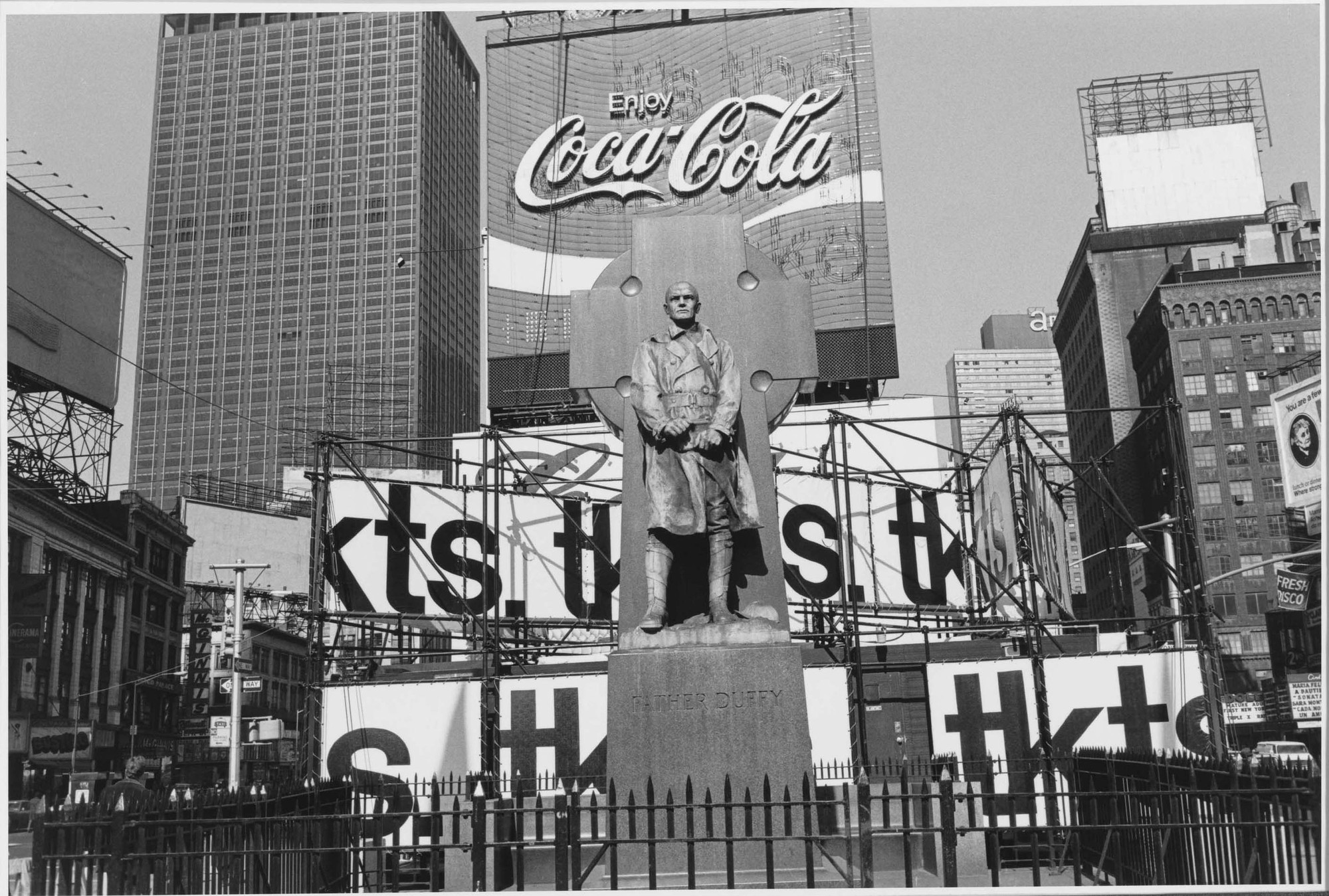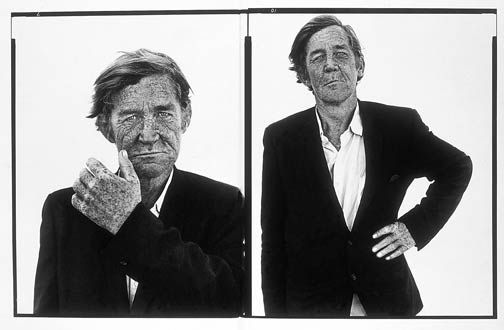Chris Killip and his photography work in ‘ In Flagrante’
Chris Killip, born in 1946,left school at 16 to pursue his ambition in photography, starting off small with beach photography and working his way up the photography ladder and is now teaching photography at Harvard University and is now a very famous photographer, known for his documentations of communities it hard by the industrial decline in the north east of England, while taking in the region’s culture and landscape, one of his books showcasing this. ‘In Flagrante’, published in 1988, is what I will be talking about here.
I’m going to show some examples of his work and try and work out what techniques he used.

In this photo, titled ‘Brian at the Disputed Fence’, you can see a group of people standing by a wire mesh fence with barbed wire on top, with ‘Brian’ presumably in the middle, now it’s clear the black and white of this photo was a choice, as coloured photography was readily available then, this clearly is supposed to show the all around bleak attitude of the setting, being the industrial decline, a lot of people had lost their jobs, so this photo is probably supposed to show these people looking at a factory where they once worked. You can notice, by the way everything is slightly blurred, that Killip used a longer shutter speed for this photo, the blurriness probably represents how the workers felt dizzy and a bit lost when they had all lost their jobs. This is also shown by the slanted shot, normally used to symbolize just that, an uneasy, unbalanced feeling.

This photo, titled ‘Rocker and his toad’, black and white is again used, which is an on going trend in this series of photos, but if you’ll notice, the background seems to have a bit more colour in it, at the very least a warmer tone to it, I believe this is supposed to show the innocence of children and how they find joy in anything, and how his generation will have to carve their own future to fit with the industrial decline, in this photo a smaller f-stop was used, you can tell with the main focus, presumably ‘Rocker‘ is more crisp and defined than the background and the dirt behind him, which in my opinion symbolizes a child’s clear tunnel vision when they found something of interest, which would be the toad he is holding in his hands. You can also notice how the camera has a lower angle for this photo, clearly on a different level to the main focus, looking up at said focus.

This Photo, ‘Seacoal Camp’, again, sports the black and white look, this time also incorporating the rule of thirds, i’m my opinion, to show that everything comes to a balance at the end, as this is a very balanced shot, with a large f-stop used here, as the depth of field is very large here, also being taken from quite a low angle really shows the lack of, well, anything in this frame, with only two people on horses and a caravan taking up less than a third of this photo, this can be taken in two ways, depending on our skew, it could look like that these people have lost everything due to the industrial decline, but to others it could look like the beginning of something else, that they are rebuilding from what was left.
The Camera and equipment he actually used, according to Killip himself was ‘Linhof Technica 4”x5” hand-held which was mixed with 6×7 roll film taken on a Plaubel.‘ for the majority of the book and is credited as his main equipment. It’s clear he wanted to achieve a tone of bleakness and dispair, which was clearly accomplish with him using, like i said in all three photos, a deliberate use of black and white photography which obviously gives out the bleak vibe.
Daido Moriyama and his photography work in ’71-NY’
Daido Moriyama, born in 1938, became a photographer in a group in 1961, but became freelance in 1964 where he regularly shot near American bases in Yokosuka and received a ‘new artist award’ in 1967 and continued his career and has had many exhibits and publications, one being ’71-NY’, published in 2002, is going to be the focus of this section.
Like before, I am going to show some examples of his work and try and work out what techniques he used.

In this photo, you can again see the deliberate choice of black and white imagery, but here it seems to be used in a different way, similar, but different, it shows, in my opinion, the coldness and slight soullessness cities seem to have compared to more rural areas, and with the slanted shot used, you are made to feel uneasy and disorientated at the confusion and hustle and bustle of the city, a large f-stop was used here as a lot of the photo is very clear to see, the smoke used in the photo is representative of the uncertainty one would face when entering a new city they have never been to before, which is maybe how Moriyama felt, originally being from Japan.

In this photo, you can see a lot of the techniques used in the previous return, but this time, the camera’s at more of a low angle, showing you what the streets look like from a personal perspective, this photo represents the nightlife of a city, shown by the fact the photo is taken, well, at night, the way everything seems to reflect in the photo, which I believe was a planned decision on the part of Moriyama, as it could be interpreted as everything that happens in the city is linked and will reflect on other things that happen in the city, the f-stop in this photo is quite large, as you can make a lot of the details out in the background, the black and white again showing the coldness that can be felt in the city, these two photo’s seem to give off the same message about being lost in the city, but this one seems more hopeful, as everything in the city is connected.

I chose this photo for a change of pace compared to the last two, but a few elements are carried over from the previous two, such as the black and white and the slanted shot, I feel a long shutter speed was used in this photo as it seems a bit blurry, but as this a photo of his photo in the book, it may just be the second photograph, the message in this one, to me, feels more like a nightmare, or a dream, as the slanted corridor makes you think of one of those crooked houses at fun fairs and the black cat in the centre is normally associated with horror or unluckiness, the black and white this time conveys the sense of terror this time, because you’re unsure whether or not the colour will come back.
The technique Moriyama uses is a funny one to say the least, he seems to take unfocused, sometimes blurry images, what most of us would call unusable, but he does in such a way, the photos look interesting, in a way, he purposely finds ways to take bad photos…to get good photos?, it may sound confusing, but looking at his photos, it’s clear that what he tried to do succeeded.
In an interview Moriyama states he takes photos to try and invoke memories to the viewer, he feels trying to convey a direct message in a photo is pointless, ‘Taking photographs for the purpose of language is for the most part meaningless for me.’. He continued to say, due to this, even he can’t explain every photo he’s taken and that the message of his photos are completely subjective. To me, a lot of the photos he took seem to show the confusion and maze like structure of cities and how an outsider feels lost surrounded by the tall buildings.
This, compared to the works of another street photographer, like Lee Friedlander, seen here:

it’s clear Moriyama’s photos rely a lot more on confusion and uneasiness of the viewer to invoke some sort of emotional response, whereas Friedlander’s work seems more to focus more of the brightness of the city, as shown by the different times of day their photos are usually taken, Moriyama wants to create confusion, whereas Friedlander wants to glorify the city and make it look alive.
Comparison of Moriyama and Killip
the difference is clear Killip’s photos show urban landscapes at a very human level, showing the people of the land coping with the hard choices they now face, where as Moriyama tries to connect with the viewer on a personal level with trying to invoke memories in them, Killip’s work seems more realistic where as Moryama’s more dream like.
Extension Task- Richard Avdon’s ‘In the American West’
Richard Avedon, born in 1923, was a famous photographer, distinguished from the rest with his work ‘the american west’, published in 1985, but the project itself last 5 years, the photos themselves turned into giant prints, as he used a special camera to get high resolution negative photos for his publication, the large size of the photos caused some problems at exhibitions. The project was simple, travel the western states of america and taking large photos of people of importance and residence in those areas.



Due to the size of each print, each had meticulous work done to them, multiple manipulations, on average about 30 or 40, and due to the special type of paper, he couldn’t mass produce his images to different people and it made them difficult to showcase in exhibitions, due to the time it took, the project took over 5 years.
The impact Avedon’s camera choice had on the photos is clear, the fact you can see nearly every detail on the subjects face makes the photo 10 times more personal, with the detail, you see the emotion in their faces and understand they are real people at the end of the day.
Conclusion: What i learnt from today, i learnt that to get a good photo, you have take everything into consideration, including time of day, angles, type of camera and type of lenses, everything, everything is important in photography.
references:
C.Killip .2016. Bio. CHRIS KILLIP. Available at: http://www.chriskillip.com/bio.html [accessed 07/11/16]
2015. Chris Killip: In Flagrante. The Telegraph. Available at: http://www.telegraph.co.uk/culture/photography/11145782/Chris-Killip-In-Flagrante.html [accessed 07/11/16]
C.Killip.2015. Chris Killip-In Flagrante Two.The Photo Book. Available at: https://thephotobook.wordpress.com/2016/03/19/chris-killip-in-flagrante-two/ [accessed 07/11/16]
D.Moriyama. 2010. Daido Moriyama Biography. OfficeDaido. available at: http://www.moriyamadaido.com/english/#/biography/ [accessed 07/11/16]
2011.Neville Wakefield [accessed 07/11/16]
2016.hot parade [accessed 07/11/16]
2015.Daido Moriyama [accessed 07/11/16]
2010.Daido Moriyama: The Shock From Outside. aperture.available at: http://aperture.org/blog/daido-moriyama-the-shock-from-outside/ [accessed 07/11/16]
2013. How to take imperfect shots like Daido Moriyama!. filmcamera999. https://filmcamera999.wordpress.com/2013/09/30/how-to-take-imperfect-shots-like-daido-moriyama/ [accessed 07/11/16]
2015.MoMA [accessed 07/11/16]
2016. Richard Avedon. Wikipedia. Available at: https://en.wikipedia.org/wiki/Richard_Avedon [accessed 07/11/16]
2015.xn--80aanuoeoma.xn--p1ai [accessed 07/11/16]
2015. Pinterest [accessed 07/11/16]

December 7, 2016 at 9:18 am
Excellent assignment, showing your analytical skills and ability to decontextualize the images you have chosen. You have made some excellent remarks about skills and techniques used by three photographers and the reasons for their choices.
Please be more careful when you write and how you structure your paragraphs and sentences. Your introduction to the assignment is poorly structured. The whole paragraphs is formed as a one sentence.
LikeLike